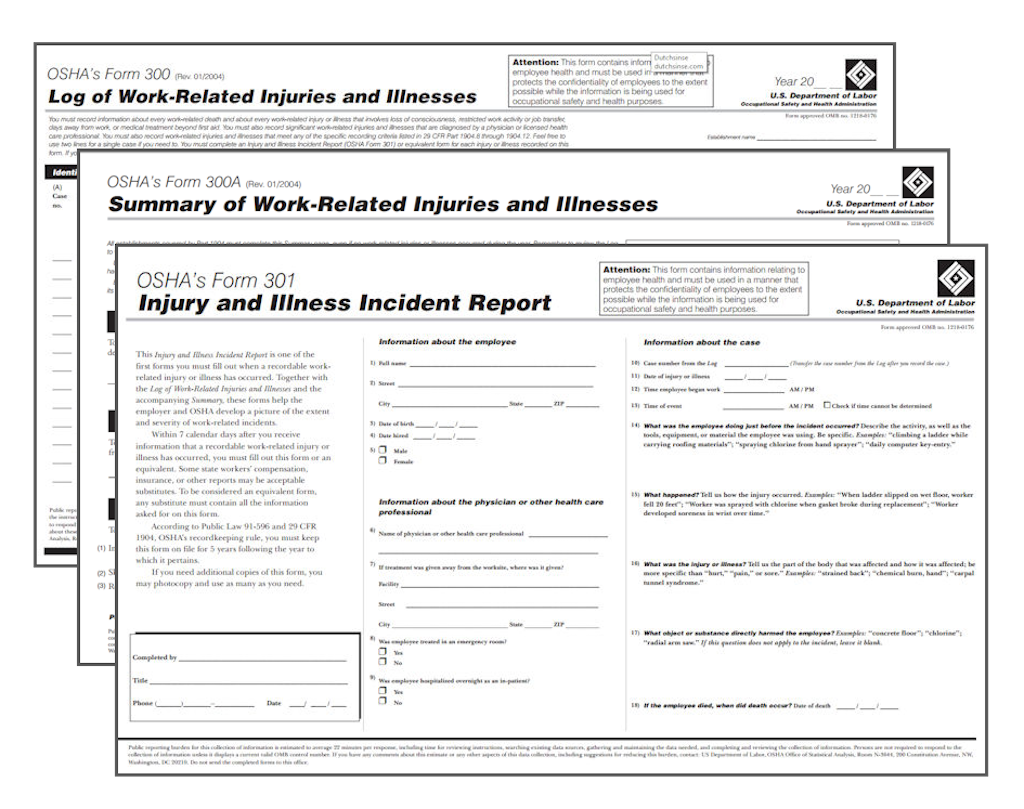Employers with 10 or more employees are required to prepare and maintain regular records of serious occupational injuries and illnesses using the OSHA 300 Logs unless they are deemed a low-risk exemption by OSHA.
This information helps employers, workers, and OSHA in evaluating the safety of a workplace, understanding its possible hazards, and implementing worker protections to reduce and eliminate hazards. It is important to always maintain accurate injury logs as the requirements are enforceable under OSHA Recordkeeping regulation 29 CFR 1904. This article will help detail the information required on each log and give tips on how to ensure timely and accurate reporting.
Recordkeeping Requirements
All work-related injuries that result in death, loss of consciousness, restricted activity, lost days from work, or any other treatment beyond first aid must be logged and accounted for on a variety of logs. These are called Recordable Injuries. The forms used to complete this documentation are the 300A, 300, and 301 Logs. All of the logs can be found on OSHA’s website.
OSHA Recordkeeping: First Steps
If a workplace injury was to occur, it is necessary to classify the case correctly and determine if the incident needs to be documented on the appropriate logs. Within seven days of the first report of a workplace injury, the following steps must be taken:
- Determine if the incident meets the criteria to be an OSHA Recordable Injury, as described above.
- Determine whether this is a new case or the recurrence of an existing injury from a prior incident. Only new cases should be recorded.
- Establish and ensure the case was work-related.
- Select and complete an Injury and Illness Report Form. This must be the OSHA 301 Form or an equivalent that includes, at a minimum, all the information found on the OSHA 301.

OSHA Forms and Logs
Form 301
The OSHA 301 Form should be the first piece of documentation completed following a recordable workplace injury. This form is used to investigate the incident and document the events that lead to the injury occurring. The 301 Form contains 18 questions that assist with determining what lead to the injury. Employers are required to complete and retain a 301 Form for each recordable workplace injury. An employer may use their own incident investigation paperwork, but it must include all of the information on OSHA’s 301 Form.
While it is not required to submit these forms to OSHA, it is required per OSHA recordkeeping regulations that one is completed and retained for five years following all recordable injuries.
300 Log
The OSHA 300 Log is a summary log of each workplace injury that meets the OSHA recordkeeping criteria. It includes information from the 301 Form and condenses it into a line item in a list format. When completed, it allows for easy comparison of all the recordable injuries that occurred during the calendar year. An entry on the 300 Log should be completed within seven days of an OSHA recordable injury. When working with the log, the following steps should be taken:
- Identify the employee involved unless employee privacy is a concern.
- Describe when and where the incident occurred.
- Describe the case with as much detail as possible using available information.
- Classify the case based on the seriousness of the outcome by selecting one of the following:
- Death (column G)
- Days Away (column H)
- Job Transfer/Restriction (column I)
- Other recordable cases (column J)
- Track the number of days an employee is either:
- Away from work (Days Away)
- Working under restriction or job transfer (Restriction/Transfer)
- Record whether the incident is an injury or an illness. If the case is an illness, select the appropriate illness on the form.
Tracking days on the 300 Log:
Determining exactly how many days to track on a 300 Log entry may seem confusing; the below points will help you successfully count Days Away or Restricted/Transfer time:
- Count the number of calendar days starting the day AFTER the incident. In other words, do not count the day of the injury/illness.
- If the incident results in both Days Away and Restricted/Transfer, both will need to be tracked.
- The maximum days counted is 180. This includes the combination of both Days Away and Restricted/Transfer or either independently.
- Only track the incident on the calendar year form in which it occurred. For example, if an incident occurs in 2019 and the days tracked continues into 2020, do not create a new item on the 2020 Log. Instead, include an estimate on the initial year’s 300 Log and then update it once the employee returns to full duty or the 180-day limit is reached, depending on which occurs first.
300A Log
The 300A Log is a summary of the information found on the 300 Log. To complete the 300A Log, you must use the information provided directly from your 300 Log.
The final piece of information needed to complete this form is the total number of hours worked at the facility and the average number of total employees. This information is used in conjunction with incident data to determine a worksite’s incident rate. You can obtain this information from payroll.
Note: Even if no recordable incidents occur during a calendar year, you will still be required to complete a 300A Log. Enter a “0” in all of the categories and input the Hours Worked information. The highest-ranking employee at the facility or another company executive must sign the 300A Log to complete.
Submission, Retention and Posting Logs
All OSHA Logs must be maintained for a minimum of five years. The 300A Form is the only log with a specific posting or submission requirement. Once completed, the 300A Form must be posted in a conspicuous location of the facility for employee review from February 1 to April 30 of each year. This could include a bulletin board, communication board, TV, or another highly visible area. Employers may be required to submit their 300A Log online annually based on their number of employees and industry. The criteria for this requirement can be found on OSHA’s Injury Tracking Application found here.
Additional Resources
https://www.osha.gov/recordkeeping/
https://www.osha.gov/injuryreporting/index.html



